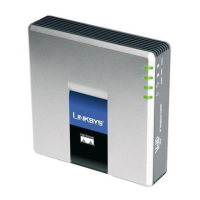Linksys Voice System Administration Guide 111
Writing an Auto Attendant Script
Configuring the LVS Auto-Attendant
Elements of XML Scripting Grammar
This section includes the following topics:
• ”Audio Instruction,” on page 111
• ”Action Instruction,” on page 112
• ”Noinput Instruction ,” on page 112
• ”Nomatch Instruction,” on page 113
• ”Menu Matched Instruction for Touch Tone (DMTP) Input,” on page 113
Audio Instruction
The following is an example of the audio instruction:
<audio src= “prompt1” bargein= “T”/>
The Auto Attendant plays the audio file that is specified in the src attribute. When playing the
audio, the Auto Attendant allows the caller to interrupt the current prompt by pressing digits
when the bargein attribute is set to T. The Auto Attendant ignores any digits from the caller if
bargein is set to F. The default value of the bargein attribute is T.
<dialplan src=”dp2”/> AA Dial Plan 2 is used to evaluate the inputs.
within this form.
<noinput timeout=”10” repeat=”T”/> If there is no input after 10 seconds, the Auto
Attendant repeats the menu prompt.
<nomatch>
<audio src=”prompt3” bargein=”T”/>
</nomatch>
If the user input does not match the specified
dial plan, the Auto Attendant plays Prompt3:
Not a valid extension, please try again.
<match>
<case input=”*”>
<audio src=”prompt4”/>
<exit/>
</case>
<default>
<audio src=”prompt2”/>
<xfer name=”ext” target=”$input”/>
</default>
</match>
If the user input matches the dial plan, the
response depends upon the user entry:
• If the user presses *, the Auto Attendant
plays Prompt 4: Good-bye.
• If the user presses any digits other than
*, t
he Auto Attendant plays Prompt 2 (Your
call has been transferred.
) The call is
transferred to the extension number that
the user entered.
</form> The form is ended.
</aa>” The script is ended.
Script Elements Purpose

